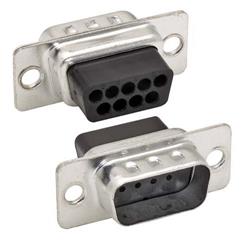For many years, serial communication was one of the chief methods of connecting peripherals (such as joysticks, printers, and scanners) to PCs. The most common connector type for serial communication was the DB9 Connector, 9-pin D-subminiature connector, or sometimes called a DB9 or a DE-9.
Nine pins were plenty to carry the data in series, and though there were many drawbacks to DB9 connectors which eventually lead to them becoming legacy in favor of standards like USB, there are still many devices with DB9 ports or cables on them today.
What are the disadvantages?
The connectors themselves are large, making them difficult to connect and disconnect in tight spaces. Also, the pins are exposed in the shell, so they can be easily bent or broken off. Though the DB9 connector can be mated without using the thumbscrew hardware, it does not tend to hold as well using just friction-fitting. If you do use the thumbscrews, the connector takes much longer to plug in and unplug.
Finally, serial communication tends to be slow, especially over longer lengths, and unexpected breaks in communication could cause software on the PC to freeze. All of these problems led to other standards becoming more popular for the same applications.
However, this does not mean that the DB9 connector is a lost cause. There are actually solutions available for many of the problems mentioned above.
For instance, L-com's right-angle D-sub adapters solve the tight-space problem by allowing a tight angle without damaging the connector. Widely available protective covers for D-subminiature plugs and jacks, D-subminiature plug and jack covers can protect pins from damage when not mated, and adapters like D-sub gender changers with male/male or female/female ports and D-sub socket savers with male/female ports can reduce the stress caused by repeated mating cycles.
On the other hand...
DB9 connectors have advantages too. In general, they are far easier to customize, with at least 9 individual pins to carry serial data. Though the speed is slower than other standards, the length of the cable can be much longer. USB, for instance, has a five-meter length limit, but RS-232 (the most common standard for serial data) has no defined length limit, and RS-422 has been used at lengths hundreds of meters long with no special equipment.
Also- don't worry if you have an old device that only has DB9 connectors on it. Even with D-subminiature being mostly legacy, there are plenty of options for conversion. Converters to and from USB, Ethernet, and other standards are common and can allow you to use your device on any computer today.
If you're looking to find DB9 D-sub cables: L-com carries products ranging from economy grade D-sub cable assemblies, economical serial cables with many off-the-shelf lengths to premium grade D-sub cables, high-quality premium cables for demanding applications. Also check out L-com's D-sub adapters such as the RJ45 to DB9 adapter for innovative solutions to common problems, and L-com's multiconductor D-sub bulk cable. In addition, check out our rj45 connector for Cat5e and Cat6 cables.
In addition to being able to provide you with a wide range of DB9 connectors, adapters, and cables, we offer you access to our inventory of more than 50,000 off-the-shelf products. Our strong inventory position means quick availability, low or no minimum order quantities and same-day shipping on in-stock product orders placed weekdays before 6 p.m. CT.
Call us toll-free at 1-866-506-2818, chat with us live, or email us atsales@l-com.com.


